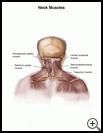
Neck Spasm
________________________________________________________________________
KEY POINTS
- A neck spasm is sudden uncontrollable tightening of the muscles in your neck caused by an injury, overuse, poor posture, or stress.
- Treatment may include stretching exercises, massage, medicine, ice or heat, and learning ways to manage stress.
- To help prevent neck spasms, use good posture when you work at a computer. Take frequent breaks and stretch your neck muscles. When you first feel tightness or pain in your neck, start the treatment that has helped you in the past.
________________________________________________________________________
What is a neck spasm?
A neck spasm is sudden uncontrollable tightening of the muscles in your neck.
Pain from neck spasms may last a few days to a few weeks.
What is the cause?
Neck spasms may happen from an injury, overuse, poor posture, or stress. For example, you may get neck spasms after a lot of computer work or from sleeping in an awkward position.
What are the symptoms?
Symptoms may include:
- Muscles in your neck that feel hard, tight, and painful
- Headaches
- Burning or a pins-and-needles feeling in your neck, head, or arms
How are they diagnosed?
Your healthcare provider will ask about your symptoms and medical history and examine you.
How is it treated?
- Stretching: Spasms are best treated with stretching exercises. Your healthcare provider may recommend seeing a physical therapist for an exercise program and other treatments.
- Massage: You may be able to massage your neck yourself by finding the tight muscles and putting deep pressure on these muscles. You might also get a massage from a friend or therapist.
- Medicine: Your healthcare provider may recommend an anti-inflammatory medicine, such as ibuprofen or naproxen, or may prescribe a muscle relaxant. Nonsteroidal anti-inflammatory medicines (NSAIDs) may cause stomach bleeding and other problems. These risks increase with age. Read the label and take as directed. Unless recommended by your healthcare provider, do not take for more than 10 days. Putting an NSAID gel on your skin can decrease pain, with fewer side effects than pills taken by mouth. Ask your healthcare provider if a prescription is right for you.
- Ice: Put an ice pack, gel pack, or package of frozen vegetables wrapped in a cloth on your neck every 3 to 4 hours for up to 20 minutes at a time.
- Moist heat: Moist heat may help relieve pain, relax your muscles, and make it easier to move your neck. Put moist heat on the sore area for up to 30 minutes to relieve pain. Moist heat includes heat patches or moist heating pads that you can buy at most drugstores, a warm wet washcloth, or a hot shower. To prevent burns to your skin, follow directions on the package and do not lie on any type of hot pad. Don’t use heat if you have swelling.
- Stress management: Neck spasms may be caused by stress or depression. It may help to talk with a counselor.
If these treatments do not help, your healthcare provider may give you a shot of steroid medicine, pain medicine, or medicine to relax your neck muscles.
- Follow the full course of treatment prescribed by your healthcare provider. Ask your provider:
- How long it will take to recover
- If there are activities you should avoid and when you can return to your normal activities
- How to take care of yourself at home
- What symptoms or problems you should watch for and what to do if you have them
Make sure you know when you should come back for a checkup. Keep all appointments for provider visits or tests.
How can I help prevent neck spasms?
Use good posture when you work at a computer or drive for a long time. Take frequent breaks and stretch your neck muscles. Keep your neck in a neutral position – not tilted to the side or tilted forward (such as when reading a cell phone).
When you first feel tightness or pain in your neck, start the treatment that has helped you in the past. Treating symptoms right away may keep them from getting worse.

